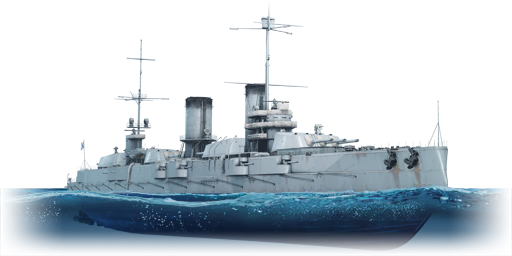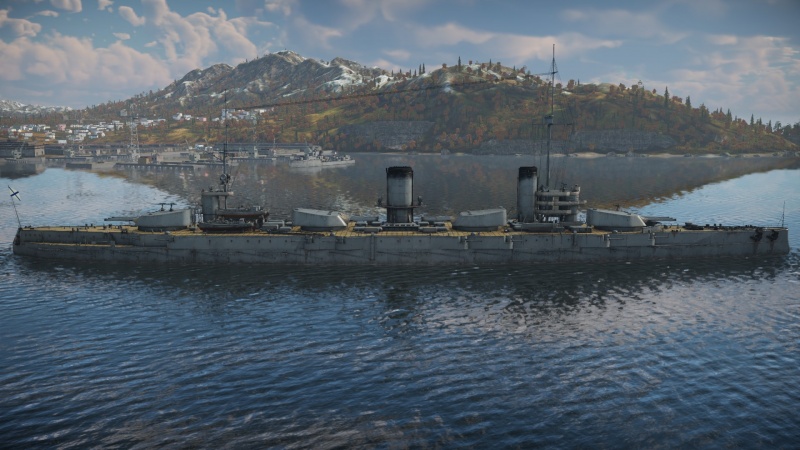Difference between revisions of "Poltava"
(→Survivability and armour) |
Colok76286 (talk | contribs) (Edits) |
||
| Line 12: | Line 12: | ||
{{Specs-Fleet-Armour}} | {{Specs-Fleet-Armour}} | ||
<!-- ''Talk about the vehicle's armour. Note the most well-defended and most vulnerable zones, e.g. the ammo magazine. Evaluate the composition of components and assemblies responsible for movement and manoeuvrability. Evaluate the survivability of the primary and secondary armaments separately. Don't forget to mention the size of the crew, which plays an important role in fleet mechanics. Save tips on preserving survivability for the "Usage in battles" section. If necessary, use a graphical template to show the most well-protected or most vulnerable points in the armour.'' --> | <!-- ''Talk about the vehicle's armour. Note the most well-defended and most vulnerable zones, e.g. the ammo magazine. Evaluate the composition of components and assemblies responsible for movement and manoeuvrability. Evaluate the survivability of the primary and secondary armaments separately. Don't forget to mention the size of the crew, which plays an important role in fleet mechanics. Save tips on preserving survivability for the "Usage in battles" section. If necessary, use a graphical template to show the most well-protected or most vulnerable points in the armour.'' --> | ||
| − | + | Poltava's main armour belt is 225 mm thick and protects the ship along the entire length between turret n°1 and n°4 and also part of the ship under the waterline. Casemates are protected by 125 mm of armour, although these are vulnerable to overpressure and cause significant crew loss when damaged. The deck is 38 mm thick and vulnerable against long range fire from certain ships such as Helena or Brooklyn due to their high angle of fire. Another layer of protection that protects machinery and magazines of turret n°2 and 3 consist of coal bunkers that add another significant protection. The other two magazines are protected by being very low under the waterline, making them very hard to hit and explode. | |
=== Mobility === | === Mobility === | ||
Revision as of 20:25, 16 January 2023
Contents
Description
The Sevastopol-class, Poltava, 1914 is a rank V Soviet battleship with a battle rating of 6.7 (AB/RB/SB). It was introduced in Update "New Power". It was the second ship of the Sevastopol-class dreadnoughts. Unlike her sister ship Parizhskaya kommuna, she did not undergo refit and did not serve in World War II.
General info
Survivability and armour
Poltava's main armour belt is 225 mm thick and protects the ship along the entire length between turret n°1 and n°4 and also part of the ship under the waterline. Casemates are protected by 125 mm of armour, although these are vulnerable to overpressure and cause significant crew loss when damaged. The deck is 38 mm thick and vulnerable against long range fire from certain ships such as Helena or Brooklyn due to their high angle of fire. Another layer of protection that protects machinery and magazines of turret n°2 and 3 consist of coal bunkers that add another significant protection. The other two magazines are protected by being very low under the waterline, making them very hard to hit and explode.
Mobility
Write about the ship's mobility. Evaluate its power and manoeuvrability, rudder rerouting speed, stopping speed at full tilt, with its maximum forward and reverse speed.
| Mobility Characteristics | |||
|---|---|---|---|
| Game Mode | Upgrade Status | Maximum Speed (km/h) | |
| Forward | Reverse | ||
| AB | |||
| Upgraded | 50 | 25 | |
| RB/SB | |||
| Upgraded | 43 | 22 | |
Modifications and economy
Armament
Primary armament
The Poltava is equipped with twelve 12-inch/52 pattern 1907 cannons in four turrets in triple mounts. The Poltava's rate of fire is slightly worse at 1.8 rounds per minute, compared to 2.2 rounds per minute found on the Parizhskaya kommuna. The cannons can use three types of shells: HE, APCBC and SAPCBC. Unlike the Parizhskaya kommuna, the Poltava does not have access to the better Pattern 1928 HE shell.
| Penetration statistics | |||||||
|---|---|---|---|---|---|---|---|
| Ammunition | Type of warhead |
Penetration @ 0° Angle of Attack (mm) | |||||
| 1,000 m | 2,500 m | 5,000 m | 7,500 m | 10,000 m | 15,000 m | ||
| 12-inch HE patt.1911 | HE | 71 | 71 | 71 | 71 | 71 | 71 |
| 12-inch AP patt.1911 | APCBC | 522 | 471 | 398 | 340 | 295 | 238 |
| 12-inch SAP patt.1911 | SAPCBC | 395 | 356 | 301 | 257 | 223 | 180 |
| Shell details | |||||||||
|---|---|---|---|---|---|---|---|---|---|
| Ammunition | Type of warhead |
Velocity (m/s) |
Projectile mass (kg) |
Fuse delay (s) |
Fuse sensitivity (mm) |
Explosive mass (TNT equivalent) (kg) |
Ricochet | ||
| 0% | 50% | 100% | |||||||
| 12-inch HE patt.1911 | HE | 762 | 470.9 | 0 | 0.1 | 47.48 | 79° | 80° | 81° |
| 12-inch AP patt.1911 | APCBC | 762 | 470.9 | 0.05 | 17 | 12.96 | 48° | 63° | 71° |
| 12-inch SAP patt.1911 | SAPCBC | 762 | 470.9 | 0.05 | 17 | 55.2 | 48° | 63° | 71° |
Secondary armament
| Penetration statistics | |||||||
|---|---|---|---|---|---|---|---|
| Ammunition | Type of warhead |
Penetration @ 0° Angle of Attack (mm) | |||||
| 1,000 m | 2,500 m | 5,000 m | 7,500 m | 10,000 m | 15,000 m | ||
| 120 mm patt.1911 HE | HE | 35 | 35 | 35 | 35 | 35 | 35 |
| 120 mm patt.1911 SAP | SAP | 143 | 125 | 100 | 81 | 67 | 52 |
| Shell details | |||||||||
|---|---|---|---|---|---|---|---|---|---|
| Ammunition | Type of warhead |
Velocity (m/s) |
Projectile mass (kg) |
Fuse delay (s) |
Fuse sensitivity (mm) |
Explosive mass (TNT equivalent) (kg) |
Ricochet | ||
| 0% | 50% | 100% | |||||||
| 120 mm patt.1911 HE | HE | 732 | 29 | 0 | 0.1 | 3.16 | 79° | 80° | 81° |
| 120 mm patt.1911 SAP | SAP | 792 | 28.97 | 0.035 | 5 | 3.73 | 47° | 60° | 65° |
Anti-aircraft armament
An important part of the ship's armament responsible for air defence. Anti-aircraft armament is defined by the weapon chosen with the control Select anti-aircraft weapons. Talk about the ship's anti-air cannons and machine guns, the number of guns and their positions, their effective range, and about their overall effectiveness – including against surface targets. If there are no anti-aircraft armaments, remove this section.
Additional armament
Describe the available additional armaments of the ship: depth charges, mines, torpedoes. Talk about their positions, available ammunition and launch features such as dead zones of torpedoes. If there is no additional armament, remove this section.
Usage in battles
Describe the technique of using this ship, the characteristics of her use in a team and tips on strategy. Abstain from writing an entire guide – don't try to provide a single point of view, but give the reader food for thought. Talk about the most dangerous opponents for this vehicle and provide recommendations on fighting them. If necessary, note the specifics of playing with this vehicle in various modes (AB, RB, SB).
Pros and cons
Summarise and briefly evaluate the vehicle in terms of its characteristics and combat effectiveness. Mark its pros and cons in the bulleted list. Try not to use more than 6 points for each of the characteristics. Avoid using categorical definitions such as "bad", "good" and the like - use substitutions with softer forms such as "inadequate" and "effective".
Pros:
Cons:
History
Describe the history of the creation and combat usage of the ship in more detail than in the introduction. If the historical reference turns out to be too long, take it to a separate article, taking a link to the article about the ship and adding a block "/History" (example: https://wiki.warthunder.com/(Ship-name)/History) and add a link to it here using the main template. Be sure to reference text and sources by using <ref></ref>, as well as adding them at the end of the article with <references />. This section may also include the ship's dev blog entry (if applicable) and the in-game encyclopedia description (under === In-game description ===, also if applicable).
Media
- Skins
See also
Links to articles on the War Thunder Wiki that you think will be useful for the reader, for example:
- reference to the series of the ship;
- links to approximate analogues of other nations and research trees.
External links
Paste links to sources and external resources, such as:
- topic on the official game forum;
- other literature.
| Admiralty Shipyards (Адмиралтейские верфи) | |
|---|---|
| Light Cruisers | |
| Project 68 | Zheleznyakov |
| Pr.68-bis-ZiF | Shcherbakov |
| Battlecruisers | |
| Project 69 | Kronshtadt |
| Battleships | |
| Sevastopol-class | Poltava |
| USSR battleships | |
|---|---|
| Imperial Russia | |
| Sevastopol-class | Marat* · Parizhskaya Kommuna** · Poltava |
| Imperatritsa Mariya-class | Imperatritsa Mariya |
| * Laid down as Petropavlovsk; renamed and remodeled by the USSR ** Laid down as Sevastopol; renamed and remodeled by the USSR | |
| Trophies | Italy |
| Conte di Cavour-class | Novorossiysk* |
| * Laid down as RN Giulio Cesare for the Regia Marina | |





